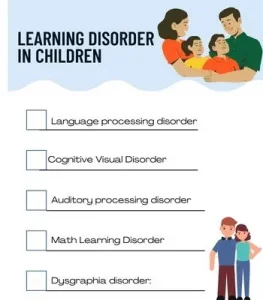Learning disorders in children
Table of Contents
ToggleLearning disorders in children
Parents may notice their children’s struggle at school when they see new signs in their children such as fear of reading aloud, solving math problems, or writing an article. Parents may imagine that a child is lazy or stupid when they have difficulty learning.
Learning disability is neither a problem of motivation nor intelligence nor are these children stupid or lazy.
Most of these children are as smart as anyone else, but their brains are connected differently; This difference affects how they receive and resolve the information. Simply, children or adults with learning disabilities see, hear, and understand things differently from other peers.
Reading, writing, solving math problems, listening, and speaking are the most common types of learning disorders in children.
If you see a particular area that is a problem constantly, it may indicate that your child has trouble learning in children.
What are the learning difficulties?
A child’s learning difficulty is a neural state that affects the brain’s ability to send, receive, and process information. Your child may have trouble reading, writing, or math. As we mentioned this does not mean they are not smart, they have a different brain in the way they receive information.
Causes of Learning Disorders in Children
Some factors can influence the appearance of science disorders in children, such as:
A family history of this disorder may increase the risk of developing symptoms in a child.
Prenatal or post-natal problems such as poor intra-uterine development, maternal exposure to alcohol and drugs before delivery, early childbirth, or very low birth weight may all be associated with learning disorders in children.
Problems during birth such as the difficulty of getting enough oxygen to the baby’s brain when it was born.
Some health conditions may be more susceptible to infection, such as people with down syndrome, children with cerebral palsy, or epilepsy, all of which may make your child suffer from learning disabilities.
Environmental problems such as childhood exposure to high levels of toxins such as lead.
Physical injuries, an injury such as head injuries at play or a nervous system infection can lead to the development of learning disorders.
Psychological trauma or early childhood addiction may affect brain development and increase the risk of learning disorders.
Many children with autism may also find learning difficult.
Symptoms of learning disorders in children.
 Children have different learning symptoms depending on their childhood.
Children have different learning symptoms depending on their childhood.
One child may have a problem reading and spelling, while the other may have a problem-solving math problem.
Some children may experience communication and understanding of what others are saying or communicating aloud.
The problems, signs, and symptoms vary, but ultimately all of them are in the learning disorders of children.
Symptoms of preschool learning difficulties:
Parents observe some symptoms and signs of preschool learning disorders such as:
Problems speaking words.
Problems learning letters, numbers, shapes, colors, and weekdays.
Trouble knowing the correct word.
Problem following trends and learning procedures.
Difficulty with coloring inside the lines.
Difficult to tie shoes and dress. Symptoms of a greenhouse from (5_9) years.
Inability to form words because of inability to merge votes.
Slow to learn new skills.
You notice persistent spelling errors that are repeated.
Difficulty learning the basics of math skills.
Trouble knowing the time.
Difficulty remembering things.
Symptoms of learning disorders in children (10_13) years of age
Spell the same words in two different ways when reading from the same sheet of paper.
Poor handwriting.
Difficulty reading, writing, and solving math problems.
Difficulty solving open questions.
Hate reading aloud.
Poor organizational capabilities such as the bedroom or study desk.
Problems with discussions with the teacher and avoiding expressing aloud.
Types of Learning Disorders in children:
The main types of learning disorders revolve around problems related to reading, writing, and mathematics, as well as some other types.
The species are:
Dyslexia disorder:
The severity of this disorder varies from person to person, and it can affect fluency in reading, writing, understanding, remembering, and sometimes even speech. This type is classified as a language-based learning disorder.
Its symptoms are:
Read slowly with difficulty during reading.
Tolerance between reading and audible text.
Spelling problem.
Hard to type.
Probability of difficulty solving math problems
Switch between short words.
How to handle this type
Provide a quiet place to read.
Use recorded books.
Use large-font books with large spaces between words.
Present materials in small groups.
Using the computer in the learning process.
Rely on multi-sensory instruction.
Make the child use logic instead of memory.
Dysgraphia disorder:
The symptoms of writing disorder in children are:
The child has difficulty writing handwriting so it is not legible in writing.
Character and word spacing are not formatted.
Poor spelling, difficulty writing, and thinking together.
Problems with the shape, tendency, and sometimes size of characters.
Write some incomplete sentences.
Difficulty in the perception that precedes the formation of the word.
Slow typing.
How to handle this type
Allow these children to record and hear their lessons at home for study.
Allow your child to use writing tools designed for them.
Focus on hearing for most of their tasks.
Use of oral examinations.
Math Learning Disorder
Math Learning Disorder is a disorder in children whose learning difficulty is such that your child is unable to understand and remember numbers and do calculations, and several other symptoms such as:
Problems with linking language and calculations.
Difficulty with time-related concepts such as days, months, etc.
Inability to organize math problems on paper due to many numbers and difficulty in breaking up ideas.
Difficulty in recognizing addition, subtraction, multiplication, and division.
Ways to handle them:
This disturbance is dealt with by:
Use colored pens.
Use counting by hand.
Use the graph to understand mathematical problems.
Use your hand to make calculations easier.
Use music and rhythms to teach children information about scientific facts.
There are other types of problems that can lead to learning disorders such as:
Auditory processing disorder
The ability to hear things correctly affects a child’s reading, writing, and spelling ability.
If the inability to differentiate in accurate sounds makes it difficult to pronounce words, understand the fundamentals of the continent, and write.
Language processing disorder
Language processing disorder is a type of hearing processing disorder that we mentioned earlier.
It is a child’s problem with language only, that is, the method of pronunciation with the use of vocal criteria that support speech and understanding of others.
Cognitive Visual Disorder
In this disorder, the child cannot distinguish between character shapes and may lose control of the pencil and hold it firmly or have poor eye-to-hand coordination.
Diagnosis of learning disorders in children.
 A child must be evaluated by a qualified medical professional to diagnose learning disabilities.
A child must be evaluated by a qualified medical professional to diagnose learning disabilities.
Diagnosis is carried out by School, psychological, and medical child assessment.
Follow common standards:
Doctors examine the child for any physical disorders that may be causing difficulty learning such as hearing and sight tests.
Learning difficulties should not be confused with hearing and visual impairments.
Children undergo a series of intelligence tests whether oral or written intelligence.
Children also undergo exams such as reading, writing, and math tests.
These tests are carried out by the children’s school specialists. A child is psychologically evaluated to determine whether child has
psychological problems such as depression, anxiety, or attention deficit and hyperactivity disorder as these disorders often accompany learning disorders in children.
Your child will be assessed on the following aspects:
Reading.
Writing.
Understand the meaning of written texts.
Understand the meanings of numbers and their relationship to each other.
Mathematical analysis such as using mathematical rules to solve math problems.
Treatment of learning disorders in children
The best treatment for the problem of learning disorders in children is the design of their educational program.
If the cause is a mental health problem such as ADHD or autism spectrum disorder, the child will need to intervene and treat this disorder to reduce learning disorders.
No drug treatment greatly improves the intelligence and overall ability of the child to learn and learn.
The family should contain the child and intervene quickly in the treatment in case of any signs or symptoms of what we mentioned earlier.
Is a child with attention deficit hyperactivity disorder have difficulty learning?
Children with attention deficit hyperactivity disorder often have problems focusing, following instructions, sitting, staying organized, and completing homework. So, this disorder does not impede learning, but it can certainly be disrupted by what we mentioned earlier.
Is the child with autism having learning disabilities?
Children with autism disorder may have difficulty reading body language, communicating, making new friends, communicating with the eye, and learning basic skills.
The End










